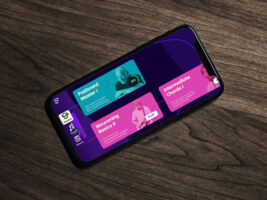
Simply Guitar review: simple isn’t always better
Note – there are two learning platforms called SimplyGuitar/Simply Guitar – this is a review of the smartphone app Simply Guitar made by Simply (formerly JoyTunes), not the web-based platform hosted at simplyguitar.com.
Given you’re here, you may have seen your fair share of adverts for ‘smart’ learning solutions across the various corners of the guitar internet. In particular, a few years ago, Simply Guitar and Yousician seemed locked in a battle to have the most ubiquitous and energetic video adverts – they’re less pervasive now, but for a while it was a running joke just how many you’d run into.
READ MORE: Til review: the best way to take video lessons with real teachers?
The, er, comedic tone of Simply Guitar’s ads no doubt helped cement them as memes, but beyond the yelling there are some serious promises being made in all of Simply Guitar’s marketing material about the platform’s teaching ability. So, let’s dive in and see if they’re kept.
Who is Simply Guitar for?
Simply Guitar is a smartphone-based learning app aimed at anyone who’s totally new to guitar and who might feel intimidated by more traditional learning paths. Like Yousician, a lot of Simply Guitar’s marketing lampoons YouTube video lessons as obnoxious and unfriendly to beginners. Regardless of the truth of that, it presents itself as an alternative, promising to make the guitar far more friendly and accessible with a mix of smart features and professionally-made video lessons.
Its beginner focus means there’s very little theory explored in the app, and it sticks to very simple tabs and chords, with almost no rhythm notation. Hence, If you have some basic theory knowledge from another instrument, or more than a year or so’s experience on the guitar, Simply Guitar’s approach may be too simplistic for you. It is also probably not for you for other reasons, no matter your skill level, but we’ll get on to that.
All Ages
As well as being a general “beginners” app, Simply Guitar is also vaguely pitched as “all ages”. There are a good amount of kid-friendly songs to play, including a few Disney tunes alongside a wide range of modern pop. While some learning platforms seem to forget the existence of music released after 1986, it’s refreshing to see artists like Olivia Rodrigo, Dua Lipa, Ed Sheeran, Post Malone and Sia make a showing here… sort of. More on that later.
Some effort has been made to keep the tracks family-friendly, too. I don’t hear a single swear word across my time with the app (not counting the ones I say). Songs are sometimes tweaked to minimise adult themes – for instance Why Do You Only Call Me When You’re High has been bowdlerised to simply Why Do You Only Call Me, and the version of ooh la la by Run The Jewels ends before you’re told the four-letter verb you should do to the law. It is not, however, a completely sanitised experience: the full lyrics of Hurt are included, and a lot of racy classic rock tunes are left untouched in the lyrics department.
So, yes, a broad age pitch does mean inevitable compromise. For very young learners it’s definitely not the most engaging platform out there – I mean, just look at the Loog app’s colourful cast of characters and contrast them to Simply Guitar’s fairly bland tablature. Conversely if you’re above the age of 13 you’ll likely find the skits and bits within the video lessons – replete with comedy explosions and shouting – irritating rather than funny.
The Simply Guitar experience
The main loop of Simply Guitar is this: you select a course, and then go through a series of short training exercises, leading up to performing “full songs” (those quotes are foreshadowing) to cement each course’s ideas. Video lessons are interspersed throughout the courses, with a presenter popping up to explain and re-state different techniques, chords and strumming patterns as and when they’re needed.
The courses themselves are split into two paths – chords and lead. The chords path focuses on the skills needed for campfire strumming, while the lead course drills down on riffs and melodies. They occasionally convene for courses that cover both. Notably the whole app is pretty electric/acoustic agnostic – when I sign up, it asks me what kind of guitar I have, but this appears to impact nothing.
A given lesson goes over the finger positions of any relevant chords, and then gives you a chance to practice the upcoming chord changes, riffs and melodies. Here you’re actually playing the notes, with the app listening to check you’ve done so correctly. You can work through the initial chord changes and melodies at your own pace, before playing some of the parts in time to a generic drum track. You’ll then put it all together to play along to a song from the library.
For the sections where you’re playing along to music, the tabs/chords scroll across the screen and work on Guitar Hero rules – hit the right note or chord at roughly the right time, and you’ll get to keep going. If you completely mess up too many times in a row, the track rewinds a bit and makes you try again. You can’t proceed to the next lesson within the course until you get through each part without triggering this rewind. Things broadly stick to this formula across all of the app’s lessons.
I will start with a positive: the videos that are dotted throughout the lessons, despite an occasional reliance on cringey humour, are well-presented and clear. It’s always helpful to see a human demonstrate how to fret a chord rather than just look at a chart, and here there are some good visual enhancements used to make things obvious. The main video presenter is particularly good at slowly and patiently explaining the basic elements of guitar.
However, there will be long stretches where it’s just you and the open road of tablature – the stop-offs for the human-presented lessons are far less common in some courses. For these stretches, you’re left with the smart “instant feedback” system – the thing that listens to your playing and tells you how well you’re doing – as the main voice of authority. How well does that work?
Detection issues
From a purely technological standpoint, the detection is reasonably functional for single note lines. And boy, that’s a sentence with a lot of caveats. The app occasionally hears itself and registers a false positive – you can mitigate this with headphones, but this does mean you’re going to have a harder time hearing your own playing – and given there’s no desktop app, there’s not really an easy way to mix guitar and app audio through your headphones. Plus if you’re using one of those new-fangled phones that doesn’t have a headphone jack (IE, most of them), this might introduce a little bit of bluetooth latency without a dongle. And latency is the last thing Simply Guitar needs, for reasons we’ll explore in a moment.
None of that is ideal, but it’s the chord detection where the cracks really start to show. During a lesson, I lean away from my phone to cough. There’s a swoosh, a boop and a big animated tick. I’d apparently just coughed a perfect Fmaj7. I try whacking my (muted) strings. A perfect D major. A tuneless pickscrape? To Simply Guitar, an E minor.
In short – its chord detection is simply not really functional. You can play the wrong chord, drop your guitar, have a bin lorry go past the window – Simply Guitar often just can’t tell the difference. Rhythmically, it’s much more of an issue – when I sustain the same chord, Simply Guitar registers it as multiple strums. This means that there’s no real way for it to tell me whether I’m playing a strumming pattern correctly, as it registers my first strum as half of the entire pattern.
I ask Simply Guitar’s team about ways to mitigate this, and I am told to use a cleaner tone and a lower volume, with the phone not too close to my amp. But, this had all already been with a clean tone at standard home practice volume. It obviously gives me extreme pause as to the reliability of the whole system if it can’t tell the difference between a guitar and a coffee grinder.
Before these detection issues, Simply Guitar was coming across as a pretty basic but fairly harmless tool for beginners. But we now reach the point where the review score realises, Wile E Coyote-style, that it’s run off the cliff, and plummets. It will not be getting better from here.
Feedback on the feedback system
So, even in a world where Simply Guitar gets its detection working, the actual feedback system also needs a major overhaul to be an effective teaching tool. “Strum along to the songs you know and love, and receive real-time feedback to keep you on track,” Simply Guitar’s website says – but here’s the main drawback: the feedback is almost totally binary. You either hit the right note at sort of the right time, or you don’t. That’s as nuanced as it gets in the heat of the moment, and after the song ends, you’re just told how many notes/chords you missed.
Playing perfectly in time is, to Simply Guitar, just as good as playing an eighth-note behind the beat. There’s no “ok, good, great, perfect” scale for your timing as there is in Yousician. You’re given far too much leeway as to what counts as in time, and the app has absolutely no way to tell you to improve on this, or indeed on any particular aspect of your playing beyond just ‘general accuracy’. And it is measuring accuracy with a system that, at least in my experience, only sometimes works. You could progress through every lesson in Simply Guitar’s catalogue while developing absolutely no internal clock, playing everything wildly out of time – you’d still come out with a perfect score.
This is made worse by the fact there’s no actual rhythm notation, formal or informal, and the tabs are occasionally extremely simplified versions of a vocal performance. There’s no grid beyond bar lines, no time signature indicated, and how long a note is meant to be sustained for isn’t shown. When you’re playing a three-note version of a complex vocal melody, and a pair of eighth notes looks basically the same as a dotted eighth note next to a 16th note, the timing of what the app actually wants you to play is totally inscrutable.
Similarly, there’s no tempo control of the songs or lessons – at least, not on the version of the app I’m reviewing. When I ask Simply Guitar’s team about tempo adjustment, they send a screenshot that depicts a set of buttons that I do not have. It turns out that tempo control – as well as the ability to move around within a song – is iOS-exclusive.
Having such an essential feature locked to your operating system isn’t great. The team assures me that it’s being worked on, but at the moment one of the most vital aspects of learning music – playing something slowly and accurately before speeding it up to a more sensible tempo – is exclusive to those within the Apple ecosystem.
But hey, do you know what’s not iOS-exclusive? The metronome. Because there isn’t one. This exacerbates my concerns about the app’s loose approach to timing – if I could do one thing for my younger self guitar-wise, I would sling a metronome through that time portal, ideally at my own head, attached to a note that said “bloody well use this, you idiot.” 16 years after I started, I am still paying for the fact that I learnt to play via untimed guitar tabs without really ever bothering to keep an internal clock.
My point is, being early on in your playing journey does not mean you should ignore this stuff. Simplifying music to make it more accessible is a commendable goal – but not if it comes at the expense of the cornerstones of musical language. Not including a metronome in your learning app is like not teaching a new driver what a red light means, in case they get demotivated from learning how powerslide. You may be skipping straight to the exciting stuff, but it’ll likely introduce some problems down the line.
The song library
Now, maybe you don’t sign up for Simply Guitar for its technique-developing courses and video lessons. Maybe you’re drawn in by the oft-repeated promises of being able to learn your favourite songs quickly – to a degree where you’ll greatly impress your friends, if you believe the ads. The song list is great – it strikes a balance between guitar-driven classics, well-known contemporary pop and Disney earworms. But sadly, there are some pretty big barriers to Simply Guitar’s performance as an engaging and effective song-teaching tool.
Firstly, the library is effectively all cover versions, and a lot of them are slowed down quite noticeably – irreversibly so for Android users. The fact they’re covers isn’t in itself awful, but it’s not something Simply Guitar makes obvious in any of its marketing – the whole app is peppered with photos of the original artists, after all. The pitch is that you’ll enjoy learning guitar so much more when you can “strum along to the songs you know and love,” not strum along to a slowed-down, mildly unsettling Björk impression.
(Side note: the Björk song included is her cover of It’s Oh So Quiet, originally by Betty Hutton – but it isn’t the Björk original. So you’re listening to a cover of another cover, and seemingly reason that the song is listed as a Björk track not a Betty Hutton track is that the vocalist is doing their own version of Björk’s unique delivery and Icelandic accent. I cannot imagine any reason for this to have happened, but here we are.)
The inability to slow or speed the songs up on Android obviously throws a bit of a spanner in the works from a pure “learn a whole song” angle, and I do think it’s pretty unfair to have an Android user pay the same as an iOS user for a tool that’s less capable. But this isn’t the only barrier to learning songs using Simply Guitar – there’s also the awkward fact that Simply Guitar’s transcriptions often aren’t anything close to the actual guitar parts.
This manifests in a few ways. Firstly, all of the songs in the library are taken straight from the lessons they appear in, with no variable complexity to choose from. Unlike Yousician’s system where the same song is presented as multiple versions depending on your chosen level of difficulty, songs here are the level that they are – with only a few appearing multiple times across the courses.
Take Creep as an example. Its chord progression is evocative and easily recognisable – you, as a beginner, might want to use the guitar tuition tool you’ve just paid for to learn it. But because Simply Guitar uses Creep to demonstrate changing from E major to E minor in a very early lesson, you get a transposed version of the song that doesn’t indicate the strumming pattern, or include two of the four chords. Creep doesn’t come up again, so the app is incapable of teaching the rest of the song. “What the hell am I even doing here”, indeed.
Further down the chords path, strumming patterns are introduced. Despite using covers, Simply Guitar doesn’t modify the arrangements to reflect the guitar parts it wants you to play. While learning to play a Rihanna song with just open chords, you’re not hearing an acoustic version of the track. You’re instead playing along to a full pop arrangement, amongst which your strumming pattern gets more than a little lost. Combine this with Simply Guitar’s inability to accurately recognise the rhythm of a strumming pattern, it really starts to feel like it’d be better in basically every way to open up a free YouTube lesson for a campfire acoustic version of the song.
For the lead path, the melody transcriptions are often just barebones interpretations of the vocal line, even when the guitar part is likely what you came for. It is extremely strange to open up a lesson on The Thrill Is Gone, as part of “Lead Foundations III” only to not be taught that iconic opening lick. Instead you’re given a four-note version of the vocal melody. This may well be more instantly accessible to a complete beginner’s skill level, but is it really a sensible compromise when you have ostensibly signed up to learn the guitar?
When the transcription does cover guitar parts, they’re often simplified beyond recognition. Whole Lotta Love is a simple and iconic guitar riff, and a reasonably slowed-down version of it is definitely within the grasp of a beginner guitarist. But Simply Guitar transcribes it as follows:
It’s fair to say that if you play this as written in isolation, no one is going to recognise it as Whole Lotta Love. This simplification is ostensibly in service of the app’s beginner focus – but again, you’re still hearing the “real” riff as you try to sightread a different rhythm. I’d argue it would be simpler – and more rewarding – to teach the riff as played, even if it means using a slower version of it without the bends at first.
No shortcuts
I am trying to keep in mind that beginner-focus, of course, because it is obviously not a good idea to try and teach someone who’s just learned their very first chord a perfectly accurate version of the main riff to Sweet Home Alabama. However the complete disconnect between what you’re being asked to play and what you’re hearing is troubling, and made worse by some other major limitations with the platform. Namely: the complete lack of any mention of slides, bending, hammer-ons or pull-offs.
Simply Guitar’s team tells me the app is made for “novice players that are looking to master open chords, tab reading, strumming patterns, finger-picking and riffs,” hence these techniques are absent. But this seems like throwing an entire orphanage out with the bathwater – how are you going to “master” most of these categories without an understanding of basic guitar techniques, and how they’re commonly transcribed? Mastering riffs surely includes at least acknowledging the existence of the techniques used to play them.
There are courses here called things like “Fretboard Master”, promising to let you “take command of advanced guitar solos.” Let’s look at one of the lessons in that course – blues licks. Yes, there is a lesson on blues licks that makes no mention of bending, which is just such a bizarre thing to attempt. It uses Howlin’ Wolf’s Smokestack Lightning as its end point. You can hear the main riff being played, slides, bends, pull-offs and all – but the platform doesn’t support these, and so the riff is not transcribed accurately. You’re just left wondering why either a) why the lesson is ignoring half of the riff, or b) why what you’re playing just sounds wrong compared to the track.
You might hear the song and think, “oh, that sounds cool – I want to play like that” – and you can. Slides, pull-offs and bends are totally within a beginner’s grasp, especially someone who has proved they’re willing to invest time and money in learning to play. But in focusing entirely on being fun and accessible, Simply Guitar has perhaps sacrificed too many vital aspects of the instrument.
Further Accuracy issues
Sometimes, the transcription is as complex as the “real” song but still inaccurate. For instance – Johnny Cash’s version of Hurt. An acoustic guitar classic, which starts with the root and the fifth… or, according to Simply Guitar’s tab, an octave jump. But not according to the guitar you hear on the track, which plays the correct fifth interval. This is one of the most advanced tracks in the app, and is basically as complex as the “real” tab, so why the incorrect transcription, if it’s not to make it easier?
I asked Simply Guitar’s team why this change had been made, and they told me that sometimes the tabs will be different to the song you’re hearing on purpose – to avoid the app hearing itself and registering a false positive. From a technological standpoint, it’s a solution, I guess. From an educational standpoint, I don’t think it’s an acceptable one. I’d be more than a little concerned about the impact of this discrepancy on a player who’s developing that all-important feedback loop between their ear and their playing.
Pricing
A blog post by a Simply Guitar developer can perhaps shed some light on why these drastic limitations exist. The post describes how, in developing the first version of Simply Guitar, the team were struggling to surmount the technological challenges presented by strumming patterns. The solution chosen was this: ship the app without actually including them.
The blog post admits that strumming patterns are vital to actually learning the guitar, but the goal was to move fast, to get the app out there and generating revenue as quickly as possible. This isn’t a leak of some internal memo – this is freely shared as part of the development journey, despite the fact it indicates a little disregard for the quality of the teaching being provided. Strumming patterns have since been added to the app, but the approach arguably persists, given that, lest we forget, the app tries to teach you how to play blues licks without mentioning bending, a task akin to teaching you how to bake without ever explaining what dough is.
But by the time a beginner can figure out what’s missing from Simply Guitar, it’s too late. The lack of any real progression beyond the total basics might be reasonable if Simply Guitar was a one-off, affordable purchase that aimed to kickstart your playing. However, the app bills you annually by default, and in the US, it’s a total of $120 a year.
I think if there’s even the option to charge by the year, then we do have to consider at the very least a player who’s about to have their yearly subscription auto-renew. At that point, they’re about to be paying $240 for two years of guitar learning with a tool that doesn’t have a metronome, a fully functional detection system, tempo control if you’re using Android, accurate transcriptions, songs by the original artists pictured in the app or support for cornerstone guitar techniques. It is, simply put, a bad deal.
Simply Guitar Alternatives
There are plenty of alternatives to Simply Guitar out there, the main one being Yousician, which operates on very similar principles. While its subscription is a little more pricey, it at least has more nuanced timing feedback, a library of the original songs rather than covers, support for techniques beyond the very basics and a way to progress through various levels of difficulty as your playing improves. With that said, it still does rely on a rather informal approach to timing, but its ‘bouncing ball’ take on the Guitar Hero format is better than the spartan approach to rhythm Simply Guitar employs.
If reading this has understandably soured your thoughts on “smart” apps, you may of course want to look into something a little more analogue and straightforward. Guitar Tricks has some beginner courses while also allowing you to actually progress beyond the walled garden of techniques Simply Guitar places you in. Alternatively, there is an absolutely huge collection of beginner content out there on YouTube for free, most of which is far more comprehensive. Even if it’s not as clearly structured, it’s a much better way to learn the campfire acoustic versions of tracks that Simply Guitar has to offer.
Even Songsterr is a viable alternative to Simply Guitar – its free version has fairly accurate tabs for most of the popular guitar songs out there (although take none as gospel), and will teach you at least formal rhythm notation at the same time. Are community-sourced or AI-generated tabs always 100% dead on? Of course not, but Simply Guitar is also not a source of truth in this regard.
If you want to have real feedback on your playing, rather than just going through passive video lessons and/or a load of tabs, your best bet is realistically to get a teacher. I recently looked at Til, a great platform that lets you connect with real human teachers in one centralised place. While it is a good deal pricier than any of the above, the depth of feedback you will get is a universe beyond anything an app can provide by listening to your playing.
The post Simply Guitar review: simple isn’t always better appeared first on Guitar.com | All Things Guitar.
Source: www.guitar-bass.net












